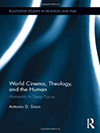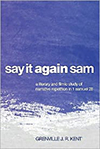- Author(s): John Matturri
- When: 1988-02
- Where: The Center Quarterly
The climax of Radio City Music Hall's Easter pageant occurred at the end of the film as its screen was replaced by a stage-set cathedral altar. This transformation was not an arbitrary whim of holiday programming. S.L. Rothafel, the Music Hall's founder, conceived the theater as a site of civic spectacle whose shows would "commemorate beautifully, tastefully, reverently. . . the holidays, the religious festivals, the seasons as they pass during the year." He believed that motion pictures should embody "a living idea" and that they should form one of a community's centers. Such theaters would use film as the primary element in a total spectacle that, like those presented in cathedrals, would ritually give image to basic cultural myths and norms. The publicity for Rothafel's Roxy Theater in fact heralded it as "the cathedral of the motion picture." Although Rothafel's was perhaps the most expansive vision of the potential of movie theaters, the analogy between cinematic and liturgical architecture was implicit — and at times explicit —in the design of every classic movie palace. Like cathedrals, these buildings surrounded their central spectacles with environments designed evoke an aura of more than mundane reality.






